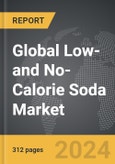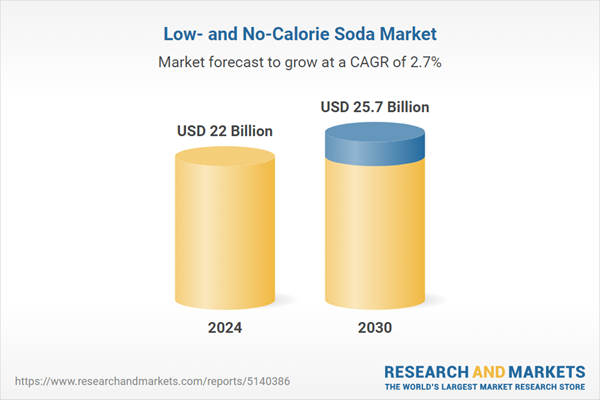The global market for Low- and No-Calorie Soda was valued at US$22.0 Billion in 2024 and is projected to reach US$25.7 Billion by 2030, growing at a CAGR of 2.7% from 2024 to 2030. This comprehensive report provides an in-depth analysis of market trends, drivers, and forecasts, helping you make informed business decisions. The report includes the most recent global tariff developments and how they impact the Low- and No-Calorie Soda market.
Segments: Product Type (Artificial Sweetener, Natural Sweetener).
Geographic Regions/Countries: World; United States; Canada; Japan; China; Europe (France; Germany; Italy; United Kingdom; Spain; Russia; and Rest of Europe); Asia-Pacific (Australia; India; South Korea; and Rest of Asia-Pacific); Latin America (Argentina; Brazil; Mexico; and Rest of Latin America); Middle East (Iran; Israel; Saudi Arabia; United Arab Emirates; and Rest of Middle East); and Africa.
The analysts continuously track trade developments worldwide, drawing insights from leading global economists and over 200 industry and policy institutions, including think tanks, trade organizations, and national economic advisory bodies. This intelligence is integrated into forecasting models to provide timely, data-driven analysis of emerging risks and opportunities.
Global Low- and No-Calorie Soda Market - Key Trends & Drivers Summarized
What Are Low- and No-Calorie Sodas and What Drives Their Popularity?
Low- and no-calorie sodas are beverages that offer fewer calories than regular sodas by utilizing zero-calorie sweeteners or reduced sugar content. These products cater to health-conscious consumers looking to manage calorie intake without sacrificing the enjoyment of a sweet, fizzy drink. The rise in health awareness and an increase in lifestyle-related health issues such as obesity and diabetes have significantly contributed to the popularity of these beverages. Consumers are increasingly scrutinizing product labels, seeking options that align with a healthier lifestyle but still provide the satisfaction and taste of traditional sodas. Manufacturers have responded by developing a range of low- and no-calorie alternatives, utilizing sweeteners like aspartame, sucralose, and stevia, which mimic the sweetness of sugar without the associated calorie load.How Has Innovation Shaped the Low- and No-Calorie Soda Market?
Innovation in the low- and no-calorie soda market is not just limited to sweetener alternatives; it also includes product diversification, packaging improvements, and marketing strategies. Brands have broadened their product lines to include a variety of flavors and formulations that appeal to a wide audience, including options fortified with vitamins and minerals or enhanced with caffeine and herbal extracts. Advances in packaging technology have also played a crucial role, with companies introducing recyclable materials and more convenient package sizes to appeal to environmentally conscious consumers and those on-the-go. Additionally, marketing campaigns have smartly shifted focus towards a lifestyle-oriented approach, highlighting not only the health benefits but also the modern, trendy image of low- and no-calorie sodas.What Role Do Regulatory Changes and Consumer Preferences Play in Shaping the Market?
Regulatory changes and evolving consumer preferences significantly impact the low- and no-calorie soda market. Governments worldwide have been imposing stricter regulations on sugar content in beverages to combat public health crises like obesity and diabetes, leading to a surge in demand for low- and no-calorie alternatives. For instance, sugar taxes implemented in various countries have made high-sugar sodas more expensive and less attractive to budget-conscious consumers, paving the way for low- and no-calorie options to gain market share. Simultaneously, there is a growing consumer preference for transparency in labeling and a desire for natural ingredients, which has pressured manufacturers to reformulate products to remove artificial additives and emphasize natural sweeteners.What Drives the Growth in the Low- and No-Calorie Soda Market?
The growth in the low- and no-calorie soda market is driven by several factors, including advances in sweetener technology, changes in consumer behavior, and regulatory impacts. Technological improvements in sweetener formulations have enabled manufacturers to offer better-tasting products without the health drawbacks associated with sugar, which has broadened consumer acceptance. Changes in consumer behavior, particularly among millennials and Gen Z, who prefer healthier, lower-calorie beverage options that do not compromise on taste, have also spurred market expansion. Regulatory initiatives aimed at reducing public sugar intake have further boosted the market, as taxes on sugary drinks push consumers towards healthier alternatives. Additionally, the global spread of health and wellness trends has created a robust demand for beverages that support a health-conscious lifestyle without sacrificing the sensory experience of traditional sodas. These dynamics are crucial in driving innovation and adoption in the sector, positioning low- and no-calorie sodas as a growing segment within the broader beverage industry.Report Scope
The report analyzes the Low- and No-Calorie Soda market, presented in terms of units. The analysis covers the key segments and geographic regions outlined below.Segments: Product Type (Artificial Sweetener, Natural Sweetener).
Geographic Regions/Countries: World; United States; Canada; Japan; China; Europe (France; Germany; Italy; United Kingdom; Spain; Russia; and Rest of Europe); Asia-Pacific (Australia; India; South Korea; and Rest of Asia-Pacific); Latin America (Argentina; Brazil; Mexico; and Rest of Latin America); Middle East (Iran; Israel; Saudi Arabia; United Arab Emirates; and Rest of Middle East); and Africa.
Key Insights:
- Market Growth: Understand the significant growth trajectory of the Artificial Sweetener segment, which is expected to reach US$15.2 Billion by 2030 with a CAGR of a 2.5%. The Natural Sweetener segment is also set to grow at 2.9% CAGR over the analysis period.
- Regional Analysis: Gain insights into the U.S. market, valued at $5.9 Billion in 2024, and China, forecasted to grow at an impressive 3.8% CAGR to reach $4.9 Billion by 2030. Discover growth trends in other key regions, including Japan, Canada, Germany, and the Asia-Pacific.
Why You Should Buy This Report:
- Detailed Market Analysis: Access a thorough analysis of the Global Low- and No-Calorie Soda Market, covering all major geographic regions and market segments.
- Competitive Insights: Get an overview of the competitive landscape, including the market presence of major players across different geographies.
- Future Trends and Drivers: Understand the key trends and drivers shaping the future of the Global Low- and No-Calorie Soda Market.
- Actionable Insights: Benefit from actionable insights that can help you identify new revenue opportunities and make strategic business decisions.
Key Questions Answered:
- How is the Global Low- and No-Calorie Soda Market expected to evolve by 2030?
- What are the main drivers and restraints affecting the market?
- Which market segments will grow the most over the forecast period?
- How will market shares for different regions and segments change by 2030?
- Who are the leading players in the market, and what are their prospects?
Report Features:
- Comprehensive Market Data: Independent analysis of annual sales and market forecasts in US$ Million from 2024 to 2030.
- In-Depth Regional Analysis: Detailed insights into key markets, including the U.S., China, Japan, Canada, Europe, Asia-Pacific, Latin America, Middle East, and Africa.
- Company Profiles: Coverage of players such as Adallen Nutrition Inc., Bai Brands, Boon Rawd Brewery, Feesers, Inc., Jones Soda Co. and more.
- Complimentary Updates: Receive free report updates for one year to keep you informed of the latest market developments.
Some of the 16 companies featured in this Low- and No-Calorie Soda market report include:
- Adallen Nutrition Inc.
- Bai Brands
- Boon Rawd Brewery
- Feesers, Inc.
- Jones Soda Co.
- LABETA, a.s.
- Madhava Foods
- PepsiCo, Inc.
- Peterstaler Mineralquellen GmbH
- Polar Beverages
Tariff Impact Analysis: Key Insights for 2025
Global tariff negotiations across 180+ countries are reshaping supply chains, costs, and competitiveness. This report reflects the latest developments as of April 2025 and incorporates forward-looking insights into the market outlook.The analysts continuously track trade developments worldwide, drawing insights from leading global economists and over 200 industry and policy institutions, including think tanks, trade organizations, and national economic advisory bodies. This intelligence is integrated into forecasting models to provide timely, data-driven analysis of emerging risks and opportunities.
What’s Included in This Edition:
- Tariff-adjusted market forecasts by region and segment
- Analysis of cost and supply chain implications by sourcing and trade exposure
- Strategic insights into geographic shifts
Buyers receive a free July 2025 update with:
- Finalized tariff impacts and new trade agreement effects
- Updated projections reflecting global sourcing and cost shifts
- Expanded country-specific coverage across the industry
Table of Contents
I. METHODOLOGYII. EXECUTIVE SUMMARY2. FOCUS ON SELECT PLAYERS3. MARKET TRENDS & DRIVERSIII. MARKET ANALYSISIV. COMPETITION
1. MARKET OVERVIEW
4. GLOBAL MARKET PERSPECTIVE
UNITED STATES
CANADA
JAPAN
CHINA
EUROPE
FRANCE
GERMANY
ITALY
UNITED KINGDOM
SPAIN
RUSSIA
REST OF EUROPE
ASIA-PACIFIC
AUSTRALIA
INDIA
SOUTH KOREA
REST OF ASIA-PACIFIC
LATIN AMERICA
ARGENTINA
BRAZIL
MEXICO
REST OF LATIN AMERICA
MIDDLE EAST
IRAN
ISRAEL
SAUDI ARABIA
UNITED ARAB EMIRATES
REST OF MIDDLE EAST
AFRICA
Companies Mentioned (Partial List)
A selection of companies mentioned in this report includes, but is not limited to:
- Adallen Nutrition Inc.
- Bai Brands
- Boon Rawd Brewery
- Feesers, Inc.
- Jones Soda Co.
- LABETA, a.s.
- Madhava Foods
- PepsiCo, Inc.
- Peterstaler Mineralquellen GmbH
- Polar Beverages
Table Information
| Report Attribute | Details |
|---|---|
| No. of Pages | 312 |
| Published | April 2025 |
| Forecast Period | 2024 - 2030 |
| Estimated Market Value ( USD | $ 22 Billion |
| Forecasted Market Value ( USD | $ 25.7 Billion |
| Compound Annual Growth Rate | 2.7% |
| Regions Covered | Global |









